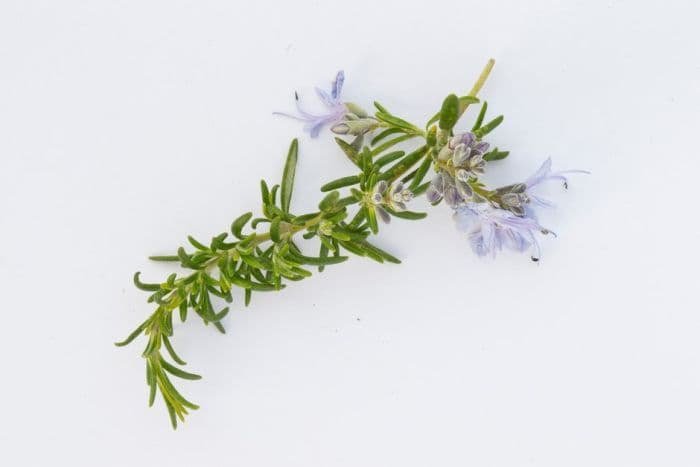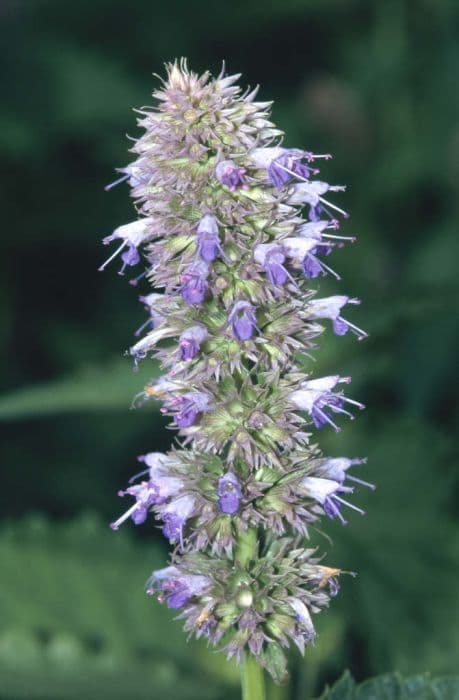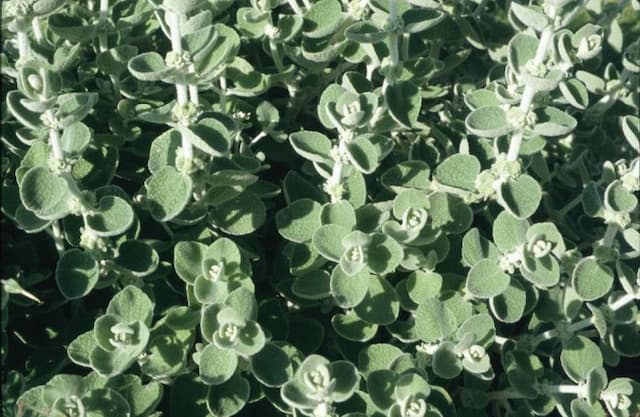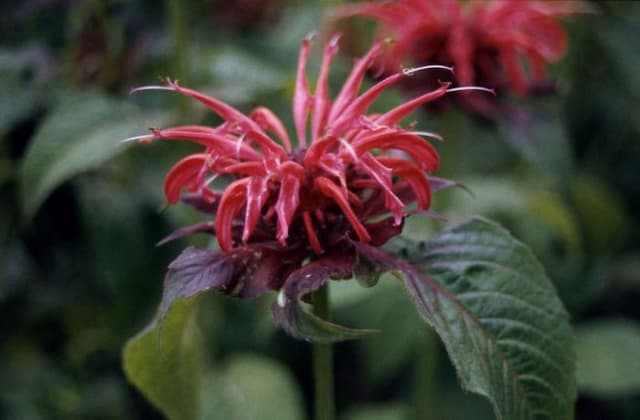Rosemary Salvia rosmarinus 'Haifa' (Ro)

ABOUT
Salvia rosmarinus 'Haifa', commonly known as rosemary, is an aromatic, evergreen perennial herb with a bushy appearance. Its leaves are slender, needle-like, and highly scented, boasting a dark green color on the top surface and a lighter, silvery-white color on the underside due to a fine, dense covering of short hairs. The plant blooms with small flowers that are a soft shade of blue, which adds a delicate contrast to the vibrant green of the foliage. These flowers are beloved by pollinators like bees. The stems of the rosemary are woody at the base, branching out into softer, more flexible stems that hold the leaves and flowers. The overall appearance of the rosemary plant is that of a dense, textured shrub with a rich interplay of color and scent, making it both visually appealing and useful for culinary purposes.
About this plant
 Names
NamesFamily
Lamiaceae
Synonyms
Haifa Rosemary, Rosemary
Common names
Rosmarinus officinalis, Rosmarinus prostratus, Rosmarinus officinalis var. prostratus, Rosmarinus palaui, Rosmarinus eriocalyx, Rosmarinus tomentosus, Rosmarinus laxiflorus, Rosmarinus officinalis subsp. albiflorus.
 Toxicity
ToxicityTo humans
The most common common name for Salvia rosmarinus 'Haifa' is rosemary. Rosemary is generally considered safe for human consumption when used in cooking or as a seasoning in typical amounts. However, consuming large quantities of rosemary can potentially lead to side effects due to its volatile oils and other active compounds. In excessive doses, it might cause gastrointestinal irritation, kidney irritation, or sensitivities, but this is rare and usually linked to ingesting large amounts of rosemary oil rather than the herb itself, which is not commonly done. Most people can enjoy rosemary with no adverse effects.
To pets
Rosemary is generally non-toxic to pets and is often used as a natural ingredient in pet foods for both dogs and cats. However, as with any non-typical food, individual pets may have different tolerances or allergies, and ingesting large amounts of rosemary could possibly result in mild gastrointestinal upset in some animals. Nevertheless, this is quite rare, and rosemary is typically safe for pets in moderation.
 Characteristics
CharacteristicsLife cycle
Perennials
Foliage type
Evergreen
Color of leaves
Green
Flower color
Blue
Height
2 feet (60 cm)
Spread
2 feet (60 cm)
Plant type
Shrub
Hardiness zones
8
Native area
Mediterranean
Benefits
 General Benefits
General Benefits- Culinary Uses: Salvia rosmarinus 'Haifa', commonly known as rosemary, is widely used as an herb in cooking, offering a distinctive flavor to a variety of dishes such as meats, soups, and sauces.
- Aromatic Qualities: Rosemary is well-known for its pleasant, pine-like fragrance, which can be used in potpourris, scented candles, and herbal sachets for a natural, fresh scent.
- Gardening and Landscaping: With its compact and prostrate growth habit, rosemary is suitable for ground cover, borders, and decorative pots, adding greenery and texture to gardens and landscapes.
- Drought Resistance: Rosemary is highly adaptable to dry conditions, making it a suitable plant for xeriscaping and for gardeners dealing with water restrictions or drought-prone areas.
- Pest Repellant: The strong scent of rosemary can help to deter certain pests from the garden, making it a useful companion plant in vegetable gardens and ornamental beds.
- Attracts Pollinators: Rosemary flowers are attractive to bees and other pollinators, which are essential for the pollination of many plants and crops.
 Medical Properties
Medical Properties- Antioxidant activity: Rosemary contains compounds that may act as antioxidants.
- Anti-inflammatory properties: Certain constituents in rosemary may help reduce inflammation in the body.
- Memory enhancement: Some research suggests that aromatherapy with rosemary may have potential in supporting cognitive function.
- Antimicrobial effects: Rosemary has demonstrated some antimicrobial properties against various pathogens.
- Digestive health: Traditionally used to support digestion and alleviate gastrointestinal symptoms.
- Hair growth: Sometimes applied topically to promote hair growth, though scientific evidence is limited.
- Stress relief: Rosemary aromatherapy has been used for easing stress and improving mood.
 Air-purifying Qualities
Air-purifying QualitiesThis plant is not specifically known for air purifying qualities.
 Other Uses
Other Uses- Rosemary 'Haifa' can be used in potpourris and sachets to give a fresh, aromatic scent to linens and clothing.
- The plant's stems can be stripped of leaves and used as skewers for grilling, imparting a subtle rosemary flavor to meats and vegetables.
- Dried rosemary sprigs may serve as a natural insect repellent for warding off moths in closets.
- Rosemary 'Haifa' has been used as a natural dye source for fabrics, yielding shades of green and sage.
- When planted in gardens, it can function as an ornamental plant to provide structure and fragrance to landscape designs.
- The essential oil from 'Haifa' rosemary can be added to homemade candles or diffusers for a pleasant aroma.
- The wood from mature rosemary plants can be carved or turned into small decorative items or jewelry.
- A decoction of rosemary 'Haifa' leaves can be used as a natural rinse to brighten hair and deepen its color.
- Fresh or dried leaves may be placed in bathwater for a fragrant, rejuvenating soak.
- Rosemary 'Haifa' branches can be fashioned into wreaths or topiaries for holiday decorations or year-round home accents.
Interesting Facts
 Feng Shui
Feng ShuiRosemary is used in Feng Shui to purify the air and promote mental clarity and focus. It can be placed in the study or the living room to enhance concentration and memory.
 Zodiac Sign Compitability
Zodiac Sign CompitabilityRosemary is not used in astrology practice.
 Plant Symbolism
Plant Symbolism- Remembrance: Rosemary (Salvia rosmarinus 'Haifa'), often associated with remembrance, is commonly used in commemorative practices, such as ANZAC Day and Remembrance Day, symbolizing the memory of those who have passed away.
- Fidelity: In folklore, rosemary is thought to symbolize loyalty and fidelity, making it a popular choice in wedding bouquets and ceremonies to represent the commitment between partners.
- Purification: Historically, rosemary has been used for its purifying properties in various cultural rituals, suggesting a symbolic meaning of cleansing and rejuvenation.
- Protection: Some cultures believe that rosemary possesses protective qualities, leading to the practice of planting rosemary by the entrance of a home to ward off negativity and evil spirits.
- Intellectual clarity: Rosemary is also associated with mental sharpness and clarity. It is believed to enhance memory and focus, hence its common usage during studying or at funerals to honor the memories of loved ones.
- Healing: With its various health benefits, rosemary symbolizes healing and has been used in medical contexts since ancient times.
 Water
WaterRosemary 'Haifa' requires careful watering as it is native to a Mediterranean climate and prefers not to be overwatered. Aim to water deeply but infrequently, allowing the soil to dry out between waterings. Typically, this pans out to about 1 inch of water every 1 to 2 weeks, although you'll need to adjust based on temperature and humidity. Use a watering can or hose to slowly add approximately 1 gallon of water per square foot of soil area each time you water, ensuring even distribution. During hot, dry periods, you may need to increase the frequency but always check soil moisture first to prevent overwatering.
 Light
LightRosemary 'Haifa' thrives in bright, full sunlight. It needs at least 6 to 8 hours of direct sunlight daily to maintain its health and produce the best flavor in its leaves. The ideal spot for planting rosemary 'Haifa' is a location where it can receive unfiltered sunlight throughout the day, making south-facing locations highly desirable for this herb.
 Temperature
TemperatureRosemary 'Haifa' prefers a temperate climate and can tolerate a range of temperatures. It should be kept in conditions where temperatures are consistently between 55°F and 80°F for optimal growth. The plant can survive occasional dips down to 30°F, but it's at risk of damage if temperatures fall below freezing. Rosemary 'Haifa' enjoys warm days and cool nights, but prolonged exposure to temperatures above 90°F may stress the plant.
 Pruning
PruningPrune rosemary 'Haifa' to encourage bushy growth and prevent the plant from becoming leggy. Spring, just after the last frost, is ideal for pruning as new growth begins. Trim back about a third of the plant to keep it manageable and to promote healthy, dense foliage. Pruning every spring and occasionally throughout the summer helps maintain a compact shape and improves air circulation around the plant.
 Cleaning
CleaningAs needed
 Soil
SoilRosemary (Ro) requires well-draining soil with a pH between 6.0 and 7.0. A suitable mix is one-third sterilized potting soil, one-third sand, and one-third peat moss or compost to provide nutrients. Regular soil testing is recommended to maintain proper pH and nutrient levels.
 Repotting
RepottingRosemary (Ro) should be repotted every 1 to 2 years, preferably during spring. Young plants may need to be repotted more frequently as they grow, while established plants can be repotted less often.
 Humidity & Misting
Humidity & MistingRosemary (Ro) thrives in moderate humidity levels, but it is tolerant of lower humidity conditions. It does well in typical home environments without the need for additional humidity.
 Suitable locations
Suitable locationsIndoor
Place rosemary (Ro) near sunny window, water when soil dry.
Outdoor
Plant rosemary (Ro) in full sun, well-drained soil, water sparingly.
Hardiness zone
8-10 USDA
 Life cycle
Life cycleSalvia rosmarinus 'Haifa', commonly known as rosemary, begins its life as a seed, which germinates in warm, well-draining soil with full sunlight exposure. The seedling stage follows, characterized by the emergence of two small embryonic leaves (cotyledons), leading to the development of true leaves as it enters the vegetative growth phase. During this period, the plant grows woody stems and needle-like leaves, becoming a hardy shrub. Rosemary then progresses to the flowering stage, typically in spring or summer, producing small, blue to purplish flowers that attract pollinators. After pollination, it sets seed, which can be dispersed to continue the plant’s life cycle. Finally, as a perennial, rosemary may enter a period of dormancy during cooler months, but it will regrow from the same root system year after year until the end of its lifespan.
 Propogation
PropogationPropogation time
Spring-Summer
Salvia rosmarinus 'Haifa', commonly known as Rosemary, is typically propagated through stem cuttings. This popular method is often performed in the spring or early summer, when the plant is actively growing and the stems are not yet woody. To propagate Rosemary by cuttings, a healthy, non-flowering stem is selected and a cutting of about 2-4 inches (5-10 centimeters) is made. The lower leaves are removed, and the cut end may be dipped in rooting hormone to increase the chances of successful root development. The cutting is then placed in a well-draining soil mix, ensuring that at least one or two leaf nodes are buried. The soil should be kept moist but not waterlogged, and the cutting should be placed in a warm area with indirect sunlight. Roots typically develop within a few weeks, after which the new Rosemary plant can be gradually acclimated to more direct sunlight and eventually transplanted outdoors if desired.









